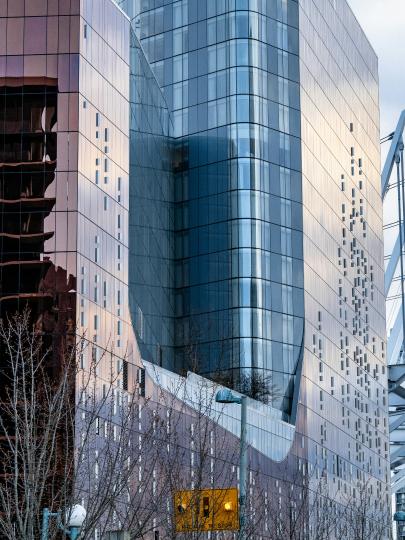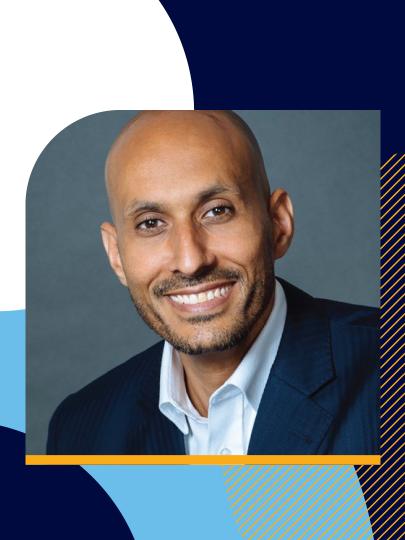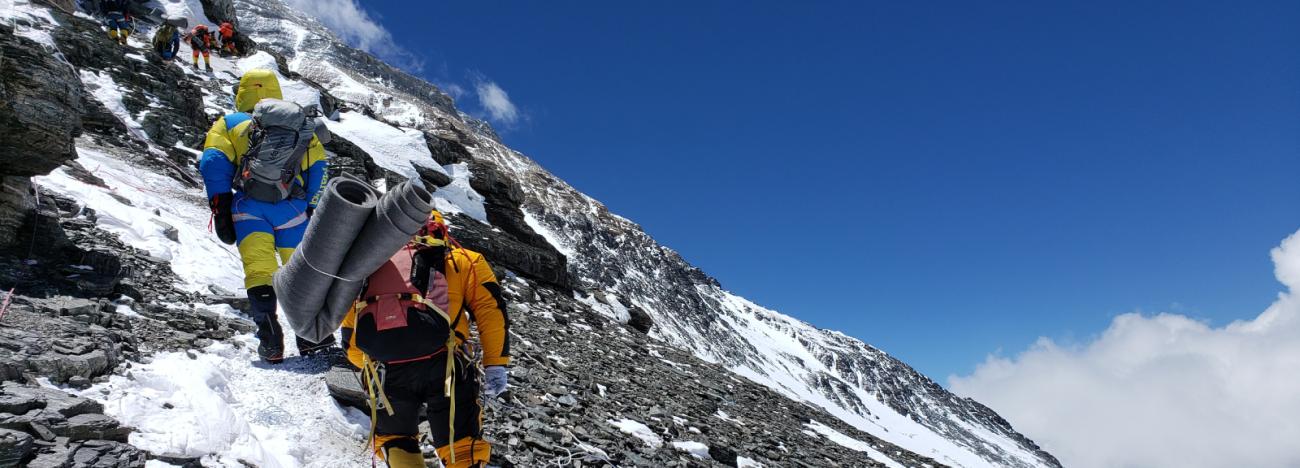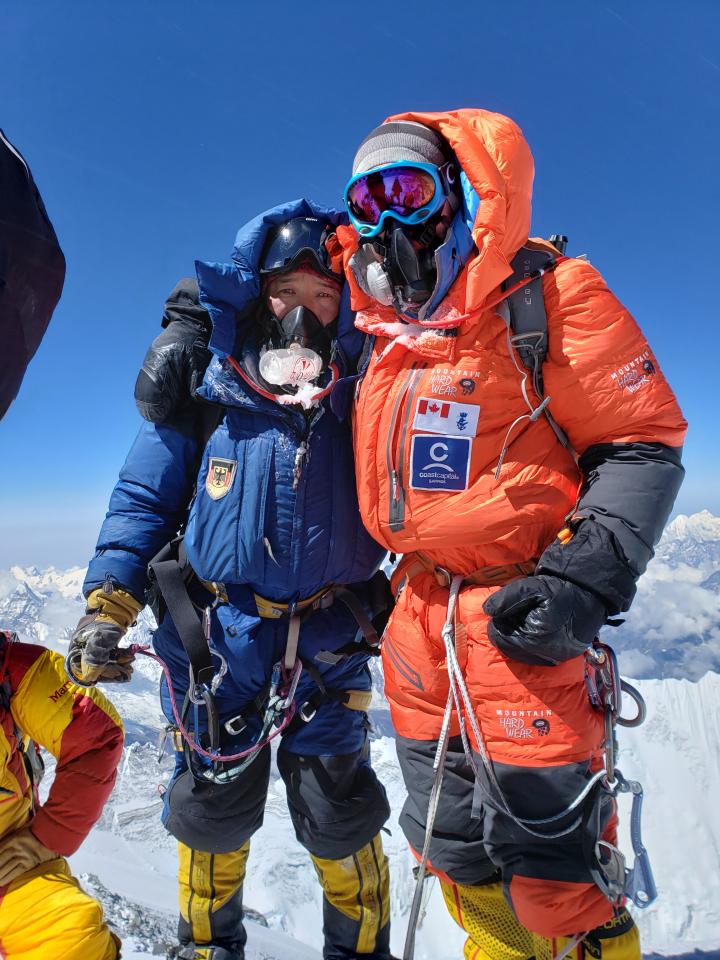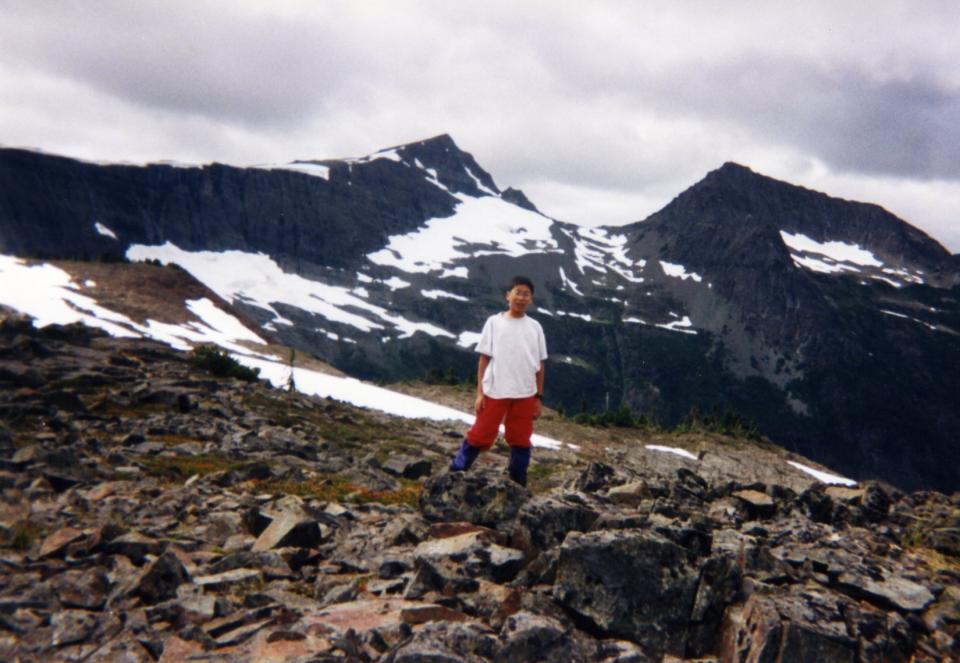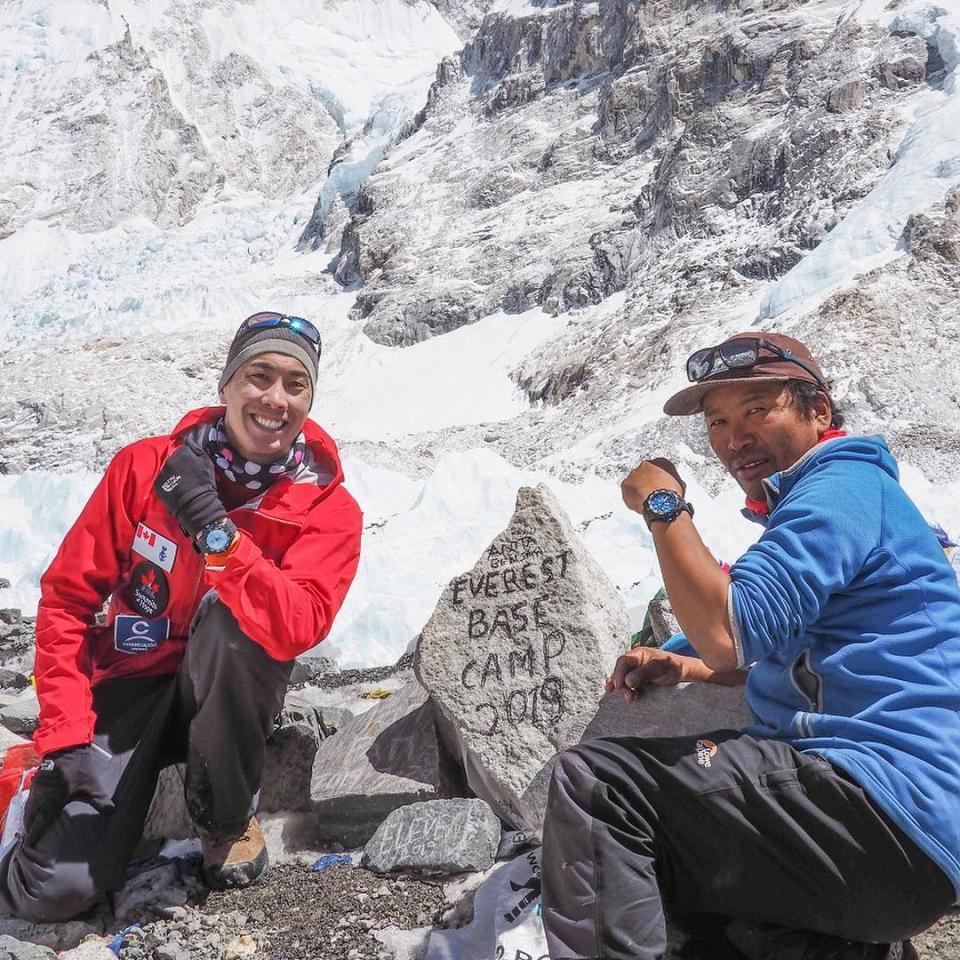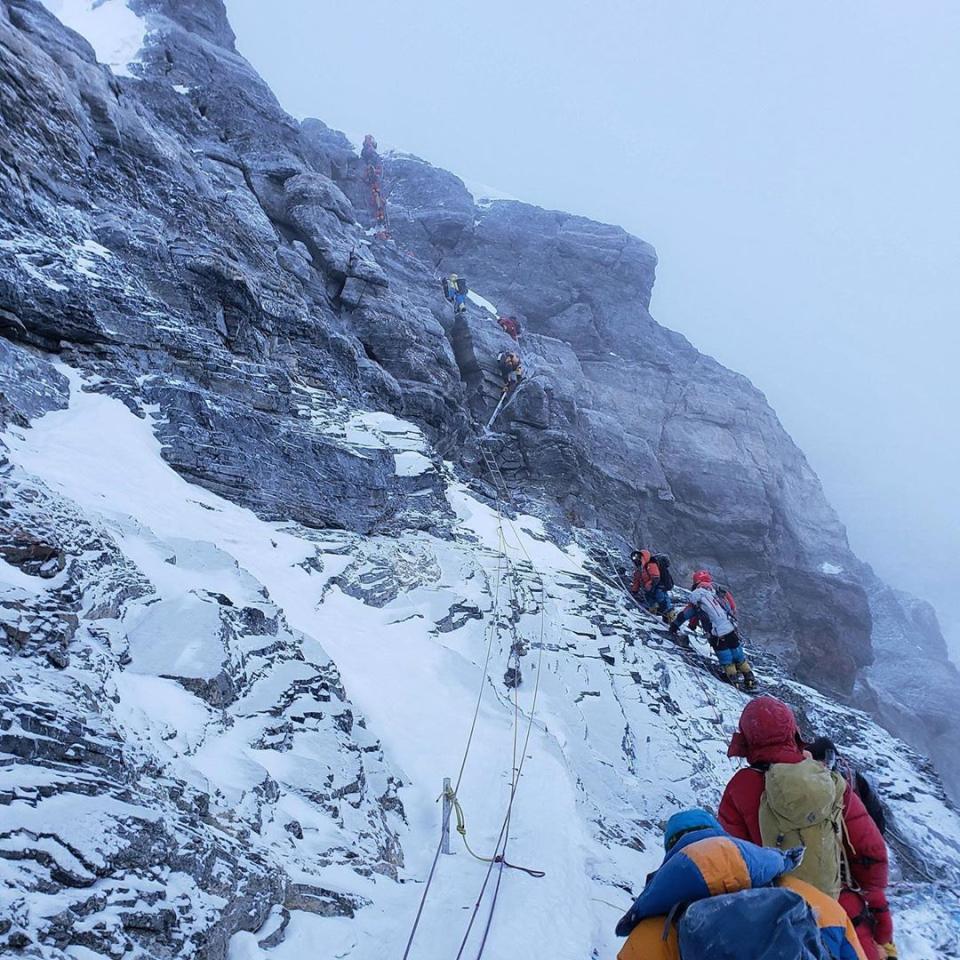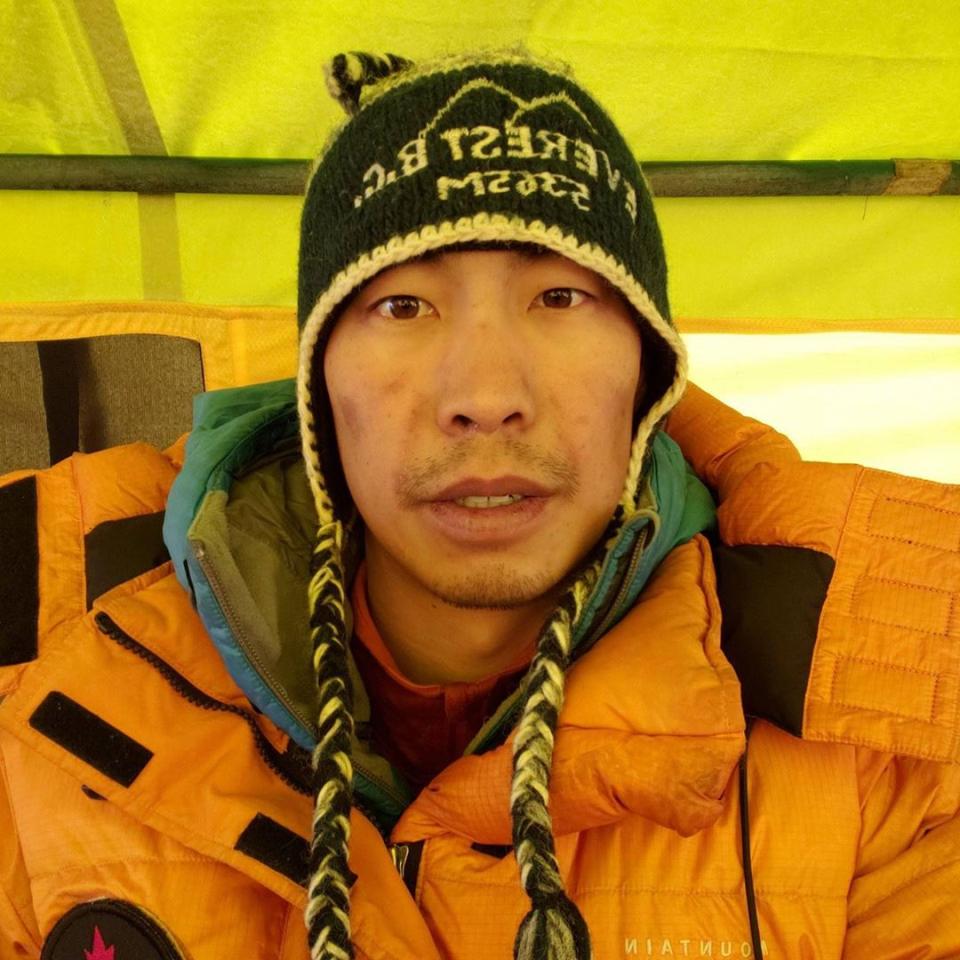Come Hell or High Mountain
Dentistry grad Chris Dare, DMD'15, has completed a challenge that few others would even attempt. This is his survival story.
Four hundred and sixteen.
That’s how many people had officially completed the Seven Summits Challenge — a 34-year-old contest to scale the highest mountain on every continent — before Chris Dare joined their ranks by cresting the 8,848-metre peak of Mount Everest on May 23rd, 2019. A moment nine years in the making, he enjoyed it for less than 10 minutes. And then the real suffering began.
For most of the year, Everest’s peak is blasted by the southwest-blowing jet stream, with -50°C temperatures and winds that average 160 kilometres per hour. In the summer and fall, the Indian monsoon takes over, bringing violent and unpassable snowstorms. But every year, about mid-May, the gulf stream shifts ever so slightly, opening a “weather window” that allows climbers to ascend from Camp 3, at 8,300 metres, to the summit. This window — usually lasting less than a week — is when climbers jostle for position to touch the highest point on Earth.
2018 was an exceptionally favourable year, with a 10-day window of little wind and relatively warm temperatures, allowing climbers to spread out their schedules to allow for quick ascents and descents. Despite hopes for a repeat, the 2019 season provided just three days of viable weather. Everyone went at once, resulting in single-file lines at the “steps” where it was impossible to pass others, and slower climbers setting the pace. The long waits meant climbers spent more time in the thin air, increasing the chance of altitude sickness and accidents. Eleven climbers lost their lives in a two-week window — one of the deadliest years ever.
At 35, Dare had already conquered the other six continents. Now, standing astride his final challenge, he cried behind his goggles as he tried to steady his sponsor flags in the wind and pose for a quick picture, keeping one eye on the storm system moving in. “That weather window was closing on us,” recalls Dare. “The summit got super windy, and the only camera that worked for me at that moment was my phone, because all my other cameras had frozen or the batteries had died because of the cold.”
His Sherpa, Nuru, tried to remove his gloves to take a photo, but his hands were too frozen. “This is a guy that, up to 7,000 metres, he doesn't even have to wear gloves,” says Dare. “His circulation somehow is so good, his hands are usually furnace-hot. But this set off alarm bells in my head, because Nuru does not get cold.” The long line had turned their planned six-hour ascent into an eleven-and-a-half-hour ordeal. Now they were low on oxygen, and the storm system was upon them.
Beaver Scouts did not prepare him for this moment. Nor did the Air Cadets corps he joined at 15. Nor the six weeks of survival training he underwent at 17, the marathons he won in his 20s, the litany of certifications he earned one after another throughout his adulthood — dive instructor, first aid instructor, outdoor survival instructor, avalanche safety training, solo skydiver. Not even the military experience he had steadily gained since he graduated from Royal Military College in Kingston in 2005.
Chris Dare survived Everest the same way every climber survives Everest: with the help of his fellow climbers, and the sheer will to live.
Dare began his summit challenge in 2010, while he was serving in Afghanistan with the Canadian Armed Forces, a 10-month deployment that was by turns rewarding and heartbreaking. As a Signals Officer in Kandahar, he supervised the maintenance of electronic countermeasures for protecting vehicles against remote-controlled improvised explosive devices (IEDs), a fulfilling duty that gave him a hand in protecting his fellow troops.
Chris Dare survived Everest the same way every climber survives Everest: with the help of his fellow climbers, and the sheer will to live.
But death was never far away. There was always a weightlifting buddy, a friend, or a friend of a friend, there one week and gone the next. He occupied his mind by taking correspondence courses to qualify for dental school.
A few months into the Afghanistan mission, he used two weeks of leave to escape the stress for something exotic, settling on an eight-day climb of Kilimanjaro in Tanzania. Though a welcome distraction, it was over too quickly, and he was back in the Middle East with eight months to go — “back to the war and the dust.”
He needed something new to occupy his thoughts and help him through the long, dangerous days. While he was in Tanzania, he had heard a fellow climber mention the Seven Summits Challenge, a feat fewer than 10 Canadians had accomplished.
“It was that moment I was back in Afghanistan, everything just looking so grim all the time. That's why I decided to do it. ”
He was fortunate to have a military career to sustain him. When he returned from Afghanistan in September 2010, he used his accumulated leave to attend LaSalle in Quebec City for a semester, gaining the prerequisites he needed to attend UBC School of Dentistry, graduating in 2015. He had never seriously considered the military as a full-time career, but as the years rolled on, it gave him the support he needed to study, train, and climb.
The mountains came and went. Russia’s Elbrus in 2010, only six months after Kilimanjaro. Denali in 2012, where his left crampon popped off and he came within inches of sliding off the mountain face. Argentina’s Aconcagua six months after Denali. Indonesia’s Carstensz Pyramid in 2013.
But after his fifth ascent, he hit a snag: money. Climbing is not an inexpensive sport. He had managed his first five summits by saving every dime he could manage and taking on small loans, shelling out between $2,000 and $15,000 per trip. But the monsters loomed; it would take $60,000 each for Antarctica’s Vinson Massif and Asia’s Everest. For three years, he was stalled, until a chance encounter in Yellowknife.
Meagan McGrath was the first Canadian woman to complete the Seven Summits, and she happened to be in Yellowknife in 2016 when Dare was on a temporary assignment there to treat patients for the military. He told her about his predicament, and she had a solution. “She turned to me,” he remembers, “and she said Chris, the best decision of my life was to take out a loan and go to Antarctica and do that mountain. So that week I took out a loan and put my deposit down to go to Antarctica.”
Dare checked Number Six off his list in December of that year, and he knew he had come too far to go back.
He arrived in Kathmandu on March 23rd, meeting Nuru in Tibet to begin pre-training. Through early April, the pair trekked up and down the mountain, as high as 6,000 metres, so Dare could get used to the altitude. They met up with a group of six climbers from 360 Expeditions, with whom they shared logistical resources, including a cook and other staff at the lower camps. Dare found a friend and mentor in 360 member Kevin Hynes — “the best person I ever met on a mountain” — an Irishman who had already scaled Everest the year before.
Around April 13th, they arrived at Base Camp. Acclimatization was over; it was time to train. Up and down the mountain they went — Base Camp at 5,182 metres, Advanced Base Camp at 6,492 metres, Camp 1 at 7,000 metres, Camp 2 at 7,500 metres, Camp 3 at 8,300 metres. For nearly three weeks, they trekked up and down, pushing a little further each time, slowly adjusting to the increasing altitude.
Mid-May rolled around and they were ready to go, but the weather was not cooperating. Even the rope-fixing team that goes ahead of the climbers to put new lines up every year couldn’t move because of the high winds.
The wait began to take its toll on their minds as well as their bodies. “No one gets great sleep at 6,400 metres,” says Dare. It takes about five days to trek from Base Camp to the summit, stopping to sleep at the advanced camps along the way. On May 17th, a window appeared to be opening to summit on the 23rd, and Dare’s team decided to pull the trigger.
A Tibetan monk blessed their journey by placing strings around their necks, connecting them to the mountain, and they were off. Camp 1 to Camp 3 involved two exhausting days and a hard night’s sleep. Arriving at Camp 3 at 4:00pm, they knew the brief weather window required them to begin the summit later that night, so after a few hours of rest, they left at 10:00pm, thinking they’d start ahead of the pack that would normally depart around midnight. But the other teams had the same thought, and Dare found himself in the middle of a free-for-all.
A Tibetan monk blessed their journey by placing strings around their necks, connecting them to the mountain, and they were off.
On the south side of Everest, there is only one step — the Hilary Step — a vertical climb where it’s impossible to pass others. But on Dare’s northern ascent there are three, and he waited in the cold for up to two hours each time, not only stuck behind those going up, but also standing aside for those coming back down.
When they finally crested at 9:30am, Dare was overcome with emotion. “I cried because of that nine years of training and preparing for this, the seventh summit. It all came crashing down. This whole thing was finally over. I made it. I don't have to worry about this anymore.”
But the goal of every Everest climb is not to reach the summit; it is to survive the trip down. The majority of deaths happen during the descent — exposure, exhaustion, pulmonary edema, cerebral edema, sudden changes in wind and temperature after the weather window closes. There is a reason the area above 8,000 metres is called “the death zone.”
The long wait times on the ascent meant they rapidly depleted their oxygen supplies, and by the time they reached the summit, their reserves were scarce for the long trip back down.
Fear is a useful thing. Dare is perfectly comfortable when he knows he has a reliable safety system in place, but he’s smart enough to be afraid when he doesn’t. “I'm okay with jumping out of an airplane because I know I'm wearing a parachute, or I'm scuba diving and I have a backup regulator and have my buddy there. But when you're on that cliff and you're in a really dangerous situation, in those moments I'm actually very fearful, and that's probably a good thing. Fear teaches you what you should be afraid of, because there are some real dangers out there. I've learned to try to suck up that real fear and just keep pushing forward when I think a lesser version of myself would want to turn around.”
Fear is a useful thing. Dare is perfectly comfortable when he knows he has a reliable safety system in place, but he’s smart enough to be afraid when he doesn’t.
Most climbers will tell you the trip down a mountain is scarier than the trip up, and on Everest, this was especially true for Dare. The ascent was an all-night affair, with the darkness hiding the long drops, the mystery dangers. But the body moves faster on the way down, so it’s easier to slip or get caught up in a rope, and with the light of day revealing the true perils to an exhausted climber who’s low on oxygen and trying to outrun a churning storm, the walk home is the most terrifying part of the journey.
Still trapped in the long lines that plagued them on the way up, Dare and Nuru crawled down the mountain, passing members of the 360 team who were still on their ascent. Dare worried for them and the others still struggling to the top, even passing along bottles of his precious oxygen to other climbers who needed it more.
Every hour that passed, the winds got worse and the temperature fell. Dare could barely walk, sometimes needing help from Nuru just to move his carabiner from one rope to the next. He stumbled and fell several times, once finding himself upside down, barely holding on to the rope.
It’s no secret that Everest is littered with bodies. Dare passed by them, one by one, the poor souls from previous summits who never managed to find their way home. Hidden by the dark on the way up, they stood out in the daylight. “The surreal thing is they're wearing the exact same gear you are,” he says. “So you're thinking, these are people that are just like me. They had training, they had the technology, and then something happened to them and here they are.”
Only two hours behind him on the descent, a climber got caught up in a rope and strangled himself while descending a rickety ladder. Later climbers related to Dare how shaken they were, having to descend the same ladder as the swinging body bumped against them in the wind.
After six hours, Dare spotted Camp 3 in the distance, and he should have been elated. But it was still a two-hour trek, and struggling beyond exhaustion, he admitted to himself the real possibility that he wouldn’t make it. “I had to tell myself, I'm not gonna die up here. I'm gonna keep on pushing. I'm not dying today.”
Nuru constantly prodded him. “Keep moving” was his mantra. “Keep moving.”
It’s no secret that Everest is littered with bodies. Dare passed by them, one by one, the poor souls from previous summits who never managed to find their way home.
Eight hours after summiting, the pair stumbled into camp. Still in the "death zone," they needed to continue their descent and reduce their altitude, but Dare could barely stand, and they had to camp for the night. Jamie, a climber from the 360 group who had turned around before reaching the summit, lost his tent in the wind. He found Dare sitting outside his tent in a daze, exposed to the elements, staring at nothing. He dragged him inside, and the two spent a hellish night sharing the last breaths from a single bottle of oxygen.
“That was brutal,” says Dare. “At 8,300, with no oxygen, you can't sleep. You're breathing, but you're out of breath. It's like you're suffocating, but just enough that you're still living.”
At 2:00am, unable to sleep, Dare pulled out his satellite phone to call his wife, Jenny. They had a quick wedding only a week before he left. He credited her as a source of strength and wanted to scale Everest with someone waiting for him at home. But the formal party had to wait. They held a 10-minute ceremony at his parents' house, followed by a hot-dog reception at Costco and a honeymoon in an oxygen tent. (Dare slept in an oxygen tent from January to March to prepare for the thin air. It didn’t help.)
The call was meant to be a source of encouragement, hearing nice things from home to keep him going. “I told her, Listen, we're at Camp 3, we're sharing oxygen, can you just tell us some nice things to distract us for a little bit? Because we can't breathe here. I was hoping that she'd cheer us up, but she just started crying.”
“So that was a bad idea,” he laughs, looking back. “But at least it distracted us for half an hour.”
At 9:00 the next morning, they began the long hike to Advanced Base Camp — a drop of 1,800 metres — trekking 15 straight hours and arriving close to midnight. Though out of the death zone, danger still lurked. A guide had lost his life at Camp 1 when his tent blew off the mountain. Several other climbers died from falls or complications from altitude sickness. Dare was devastated to learn that his friend Kevin had passed away on May 24th, after falling ill and going to sleep in his tent.
“At 8,300, with no oxygen, you can't sleep. You're breathing, but you're out of breath. It's like you're suffocating, but just enough that you're still living.”
Logistical issues forced them to spend two days at Advanced Base Camp, and then two more at Base Camp, still troublesome at nearly five kilometres above sea level. The extended stay earned Dare a final brush with death, a case of pulmonary edema — excess fluid in the lungs. In the middle of the night, unable to breathe, he woke up a British military doctor. She treated him with a cortisol steroid and a drug called nifedipine to reduce the absorption rate, but the only real cure was to get off the mountain. They left the next morning.
“I still can't believe it, to tell you the truth,” says Dare only two months after completing his journey. “I haven't had too much time to really reflect on what I'm gonna do next. It's just a weird feeling to have this big chapter of my life over. I feel like I need to have another goal ahead of me, but I don't think it's gonna be quite as big or long-lasting as the Seven Summits.”
His thoughts turn to the Marathon de Sabres — the most gruelling race on earth — or even competitive board gaming (his small Toronto condo is filled with 180 games). But his Everest adventure is still bringing its own rewards; as a partner with the charity Summits of Hope, his climb raised more than $12,000 for BC Children’s Hospital.
Whatever challenges await, Dare will accomplish them the same way he’s accomplished them all: with baby steps. “I don't even think I have a ‘greatest’ success,” he muses. “I think it’s just small steps — small steps all the way through. I think it's really important that we push ourselves to our limits and figure out who we are, and just to get better. If we never push ourselves, what are we living for?”



